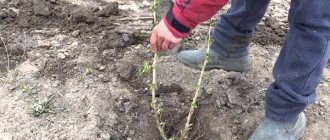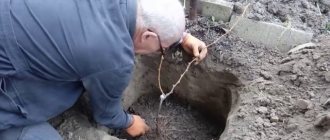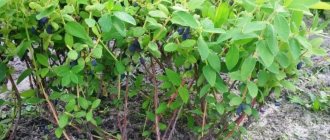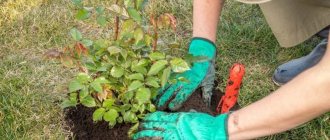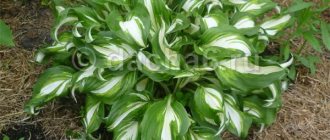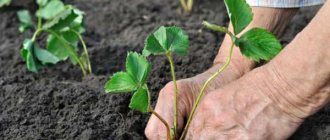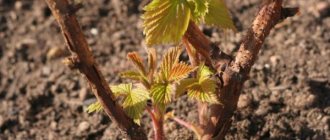Why is a transplant needed?
Basically, spring transplantation is planned and is necessary in the following cases:
- the crown has grown greatly, there is not enough space for it, it interferes with other plants;
- the site for the seedling was initially chosen incorrectly;
- a design decision to close unsightly areas of a fence or outbuilding;
- redevelopment of the site, it is necessary to free up space;
- growth stop.
It is carried out if the goal is to propagate a rare variety by division.
Unscheduled spring replanting is carried out in rare cases - if groundwater has risen to 60 cm to the surface. A month is enough for the root system to rot and the plant to die. This natural factor is determined by the previously unusual amount of dew on the branches and the fog creeping in the morning.
Planting viburnum in open ground
What time to plant
Planting and growing viburnum is not difficult at all. For it, you should choose neutral or slightly acidic (pH from 5.5 to 6.5) soil. To plant it, you should not choose areas with podzolic, peat or sandy soil. You also need to pay attention to groundwater; it must lie in the area at a depth of at least 100 centimeters. In order to extend the life of this plant and make it stronger and healthier, conditions should be created for it as close to natural as possible.
This crop can be grown in a well-lit area, but partial shade is better suited for this. According to some experts, pests settle much less frequently on a bush growing in a shaded area.
Viburnum seedlings are planted in both autumn and spring. Before planting, the area is dug up, and all weeds are removed from it. If the soil on the site is nutritious, then adding organic fertilizers to it will be unnecessary. If the area has poor soil, then fertilizers are applied directly to the planting hole during planting of the seedling.
Planting viburnum in spring
In spring, viburnum should be planted before the leaf blades open. The size of the landing pit should be 0.5x0.5x0.5 meters. If several bushes are planted, a distance of 2.5 to 3.5 meters should be maintained between them. When preparing a hole, the top layer of soil must be removed separately. It is combined with 1 bucket of peat or humus and a couple of glasses of Nitrophoska. 2/3 of the resulting soil mixture must be poured into the planting hole, and 40 liters of water are poured into it. The pit will be ready for planting in a few days. After approximately 7 days, the soil mixture that remains should be poured into the planting hole in a mound, and it should rise 10–12 centimeters above the surface of the site. A three-year-old seedling is used for planting. Its roots should be installed on the resulting mound. After the roots are straightened, the hole must be filled with the remaining soil mixture. The trunk circle of the planted plant must be compacted well, then it is watered abundantly. When the water is absorbed, the surface of the tree trunk circle should be covered with a layer of mulch (peat, compost or humus). After planting, it is necessary that the root collar of the viburnum be buried approximately 50–60 mm into the soil.
Planting viburnum in autumn
In autumn, viburnum seedlings are planted in open soil in the same way as in spring. Planting must be done during leaf fall, and it must be done before the first frost.
Timing for spring transplantation of viburnum
The culture is winter-hardy, with an early start of sap flow; spring work to change the location is carried out before the buds swell. Be guided by the condition of the soil; it must thaw to a depth of 50 cm in order to dig a viburnum and a seat for it.
Approximate dates for spring transplantation based on regional climate characteristics:
- temperate continental (Leningrad region, Ural, Siberia) - from the first ten days of May:
- temperate climate zone (Moscow region, Middle, Central zone) - from mid-April;
- regions of the North Caucasus - in March;
- subtropical zone (Krasnodar Territory) - at the end of February.
- On the Black Sea coast, you can replant viburnum in the so-called February windows - here the soil rarely freezes below 5 cm.
Viburnum care
Watering
Young seedlings are watered in the evening, shedding the soil by 40 cm. Adult plants are watered during the growing season and the formation of berries.
Viburnum berries
Feeding
- In the spring, before the leaves bloom, you need to add about 2 tablespoons of urea to the tree trunk.
- Before flowering, about 2 tablespoons of potassium sulphide are added to the tree trunk. But wood ash will work just fine.
- In mid-summer, about 60 g of complex mineral fertilizers are applied to the viburnum.
- After 2 years in the fall, when you dig up the soil, add rotted manure and combined phosphorus-potassium fertilizers. If there is a drought, mineral fertilizers can be dissolved in water.
Pruning and crown formation
Viburnum branches can grow 40 cm or more per year. It is recommended to prune viburnum in the spring; it is necessary to shape the crown and remove unnecessary and diseased branches.
For older plants, anti-aging pruning will not be superfluous. As a rule, viburnum is rejuvenated 6 years after planting. To do this, you need to cut out old shoots to the root shoots. This leaves about 15 main branches. A weak, almost non-flowering bush can be saved by pruning it at the root, to a height of about 20 cm from the surface of the ground. If your viburnum is a fruit variety, then form about 7 skeletal branches from the bush, and remove the remaining branches.
In order for the bush to be lush and bloom beautifully, shoots longer than 40 cm must be pinched with your hands. Pinching viburnum
If you prune viburnum in the form of a tree, then you need to leave one main vertical shoot and remove the rest. In subsequent years, it is necessary to remove all emerging side shoots and root shoots. As a result, you will get an even stem about 2 m high. In order for the crown to begin to form beautifully, pinch the growth point, then the tree will acquire branching. Next, you need to thin out the crown if it thickens too much.
Viburnum harvest
Viburnum berries are harvested after the first frost, then the bitterness in them disappears. The berries can then be used for drying, freezing, making compotes and jam. You can prepare viburnum with honey and take it as a tonic and restorative - 1 spoon on an empty stomach. You can learn the recipe for this vitamin and medicinal preparation from the video:
Benefits of spring transplantation
For viburnum of any age, spring transplantation is more preferable. The benefits of changing locations early in the season are:
- the tree is at rest, transfer to another area will be painless;
- viburnum is moisture-loving, the root system is already formed, a sufficient amount of water after the snow melts promotes rapid rooting and the full start of sap flow;
- by autumn it will be completely stronger, adapt and overwinter as usual;
- the opportunity to monitor the condition of the crown during the season, there is time to eliminate any problems that have arisen.
Selection of material for transplantation
Select viburnum for transfer to another place of growth based on a number of characteristics:
- blooms poorly, low yield;
- the seedling has been on the site for more than a year, there is no growth, it looks weak;
- the formation of root shoots is low, there is no replacement buds;
- perennial and young shoots dry out;
- leaves and ovaries turn yellow and fall off;
- fruit clusters are sparse, berries are small;
- low resistance to pests, treatments provide a temporary effect.
- The bush has grown and needs to be divided.
Formation
Unlike other fruit shrubs, viburnum does not require frequent pruning of shoots. Typically, shoots are removed once a year.
When forming a plant as a bush, in the spring all branches are removed by 2-3 nodes. The growth points are pinched when they reach a length of 30 cm. The awakened buds will give rise to young shoots. They will be the main component of the plant. In subsequent years, systematic pruning of viburnum will form the desired size of the bush.
If you want to see the viburnum as a tree, at the beginning of its formation you need to leave a vertical central trunk. The remaining side branches should be removed. The growth around the bush is also trimmed. After 2-3 years, a trunk with a height of about two meters will form. The crown is formed by pinching the growth point. The tip of the conductor is cut off and several buds appear at the cut site. Thanks to this procedure, the tree becomes branchy.
Growing viburnum on your own plot is not difficult. You need to know how to care for her competently. Then the plant will delight you with magnificent flowers and beautiful healthy berries.
Pruning during transplantation
Treatment of the crown and root system depends on the condition of the plant and its age. If it is young and healthy, move it along with the earthen lump, do not touch the underground part.
Actions in other cases:
- Shake off or wash off any remaining soil with water and inspect the root system.
- Remove dry, damaged shoots.
- If there are rotten areas, cut off the affected branch completely; the viburnum will quickly restore the necessary volume for proper nutrition.
- Shorten parts that extend beyond the visual perimeter.
- For seedlings, shorten all branches to 30 cm.
- For a young plant, remove annual and perennial shoots at the root, leave 1-3 stem branches, trim the tops so that the length is no more than 1 meter.
- An adult viburnum is already formed at the time of transfer. If it is a tree, remove all branches from the trunk. Trim dry, thin, weak, old and diseased branches. Unload the crown to the maximum.
- If it grows in the form of a bush, leave the stem branches, remove the rest, especially the annual basal ones. Drastic pruning will not harm, but will help it take root easier.
If the goal is propagation by division, cut off the entire above-ground part to 20 cm. Leave at least 3 replacement buds on each plot and treat the root system.
Care: how to plant and prune bushes?
You need to care for viburnum in the same way as other cultivated plants: destroying weeds, regular watering, loosening the soil in the tree trunk, mulching, cutting and forming the crown, fighting diseases and pests.
Spring flowering viburnum
Watering
Watering is carried out in the evening, shedding the soil by 40 cm. Adult bushes need to be watered during the growing season and when the berries ripen.
Feeding
Typically, fertilizing is done in dry form; in hot, dry weather it is better to dissolve it in water. You need to feed the plant several times:
- In early spring, when young leaves bloom. Urea is added (2 tbsp);
- Fertilizer is applied immediately before flowering. You should scatter wood ash (1/2 liter) or potassium sulfate (2 tbsp.);
- Fertilizing is carried out after flowering. Add nitrophoska or nitroammophoska (2 tbsp.).
- Liquid fertilizing is applied in October, when the harvest has already been harvested. Potassium sulfate (2 tbsp) and superphosphate (3 tbsp) are added to ten liters of water. Each viburnum bush requires two buckets of fertilizer
Preparing the site and soil
A common cause of poor development is an incorrectly chosen initial location or inappropriate soil type or composition. The culture prefers moist soils, but without stagnant water, which are always fertile. Sandy and peat soils are not considered; they do not retain moisture.
Viburnum is light-loving, but has low drought resistance. Allocate the area so that during hot hours the bush is in partial shade. Large plants do not grow on the north side near the wall of a building or under a dense crown. In the scorching sun, the crop will dry out due to lack of moisture.
Vegetation is possible on neutral soils, but it achieves better development and full yield on slightly acidic soils (pH 5.5-6.0). Adjust the composition in the fall, dig up the area for planting a young tree 1*1 m, for an adult - 1.5*1.5 m, the root system does not grow wider.
Add organic matter; if the alkalinity is high, add colloidal sulfur or ferrous sulfate. Reduce acidity with lime, chalk or dolomite flour.
Prepare the seat in advance or on the day of work:
- Dig a hole 60 cm deep, 50*50 cm in diameter.
- Separate the fertile soil, remove the deep soil, it will not be needed.
- Cover the bottom with a layer of expanded clay.
- Mix the turf layer with 4 buckets of compost, 200 g of superphosphate, 50 g of potassium sulfate, 60 g of urea, 200 g of crushed chalk.
- Make a cone-shaped mound of the nutrient mixture.
A planting site for an adult viburnum is dug on the day of spring transplantation; the volume and depth of the root will become a guideline for the size of the hole.
How to transplant viburnum correctly
Despite all its unpretentiousness, the plant is demanding in terms of its growing location. An adult bush is spreading and can reach a diameter of up to 4 meters.
Did you know? Viburnum is unique not only for its nutritional and healing properties. The berry seed has the shape of a heart - this is not found in any other plant.
Due to the high requirements for the availability of free space, the place for transplantation is selected as follows:
- the distance of the landing site from fences or walls of buildings should be at least 4-5 meters - in addition to constraining the bush in its development, such objects can reflect excess heat towards it;
- when replanting a plant, you should maintain the same distance (4-5 meters) from a neighboring one or a representative of any other crop;
- the best place for viburnum to grow is a slightly shaded area - in the midday shade of large trees (but not under them), or under a highly stretched agricultural mesh;
- Fertile neutral moist soils are suitable, but you should not plant in sandy or peat soils.
Soil that is not entirely suitable for a given crop can be “amended”: clayey soil with the addition of sand and peat, acidic soil with lime, sandy soil with loam and peat.
Methods for transplanting viburnum
If the purpose of the spring transfer is to free up space or design redevelopment, the plant is healthy, dig it up with a ball of earth and plant it by transshipment. Otherwise, use the bare root method. Deepen the bush 5 cm below the previous level.
Transplanting seedlings
A seedling can be replanted at any age, even if it was placed on the site at the end of the previous season.
Sequence of work:
- Dig up the plant around the perimeter of the crown.
- Lift the lump and carefully remove it from the soil.
- If the root is closed, free the lower part from the soil.
- Pour the mixture to the required height.
- Place the plant in the center.
- Fill the voids with fertile soil.
- Compact. It will turn out below the level of the pit. Pour and fill the mixture to the top.
- With the root exposed, raise the mound in the hole to the desired height.
- Place the seedling on it and distribute the roots.
- Cover with a layer of soil, compact, and water.
Replanting a young tree
The root circle in young trees is also determined by the diameter of the above-ground part.
Work algorithm:
- Dig up the plant, spread burlap or film next to the previous place, and place the bush with soil on it.
- Adjust the hole to the desired depth by adding mixture.
- Place in the center, fill the voids, water.
- Disinfect the exposed root with a 0.5% manganese solution.
- Dip into thick clay solution.
- Place it on a hill, untangle the intertwining root shoots.
- Fill with the nutrient mixture, compact, loosen the surface.
Transplanting a mature tree
It is difficult to move an adult tree with a clod of earth. Remove any remaining soil. If pruning was done, treat the cuts with activated carbon. Dip the root system up to the neck into the clay solution.
Instructions for transplanting adult viburnum:
- Step back 80 cm from the trunk - this will be the radius of the circle; perennial viburnum does not grow more than 1.5 m. The root system is branched, so the cut areas will not cause much damage to the plant when removed.
- Dig a trench in a circle to a depth of 40-50 cm. If you damage the length of the root during extraction, don’t worry, viburnum is unpretentious in this regard.
- In terms of volume, dig a hole with a depth equal to the length of the root + 15 cm of drainage + 15 cm of soil mixture + 6 cm of deepening of the trunk. Approximately it will be 70-80 cm, depending on the age of the tree.
- Place it in the hole, untangle and distribute the root shoots along the bottom, fill it halfway, rock it slightly so that the soil settles, and compact it.
- Fill with mixture to the top and compact.
When to transplant viburnum
The time for transplantation is usually chosen in spring or autumn. Preference is given to mid-spring, when the bush has time to take root before the onset of heat and strengthen before the onset of cold weather.
When planting in autumn, it is necessary to choose a time so that the crop has time to get a little stronger before the onset of winter. Therefore, she will have to help her with this by hilling and wrapping the plants when the first frost occurs.
Transplanting viburnum in spring
Transplantation of young seedlings and adult bushes in the spring is carried out according to the same scheme:
- The chosen place must be dug up in advance and fertilized with organic fertilizers.
- Dig holes measuring 50x50 cm according to a 4x4 m pattern.
- Add humus (half a bucket) and ash (1 cup) into each hole.
- Carefully collect all the branches of the bush to be transplanted upward and tie them with rope or keeper tape.
- Dig up a bush along a radius of 30 cm and remove it along with a lump of earth.
- Place the plant with a lump in the prepared hole.
- Fill with soil, compact it a little, pour a bucket of water and place several peat briquettes in the stem area.
The transplanted bush needs to be watered weekly, using 20–40 liters, depending on the size . But fertilizing will not be required this year - the fertilizers that were applied to the soil before planting are enough. Viburnum takes root well and takes root in soil suitable for it, therefore, depending on the variety and age of the seedling, it can produce a harvest in the next season.
Viburnum, for all its unpretentiousness, requires careful handling of the bush, roots and root ball during transplantation. With proper care, a transplanted plant can delight for many years with its appearance and abundant harvest of medicinal berries.
Care after transplant
For better rooting, use the “Kornerosta” solution, dilute according to the instructions. Water a seedling with 10 liters, a young tree with 20 liters, and an adult viburnum with 30 liters of water. Cover the root circle with coarse river sand to prevent moisture evaporation and the formation of compaction on the soil surface. Mulch with a 10 cm layer of one of the available materials: wood chips, sawdust, humus mixed with peat. The next day, water until moisture is absorbed. Make sure that the soil around the viburnum is always moist.
Reproduction and cultivation
Viburnum can be propagated by dividing the bush, seeds, cuttings and layering. After propagation, you can transplant the shoots into open ground.
Reproduction by dividing the bush
Typically, this method is used if the viburnum species is valuable and needs to be preserved or the plant needs to be transplanted to another location. The plant is divided into several parts. At least 3 buds remain on each part. Separation and replanting are carried out in spring or autumn.
Fruiting viburnum in a summer cottage
Propagation by cuttings
In June or early July, when the branches are flexible, the preparation of cuttings begins. When cutting, you need to monitor the number of nodes; there should be at least three. The length of the planting material is approximately 10 cm. An oblique cut passes along the lower part of the cutting, and the leaves are cut off. It is advisable to treat the material with drugs to accelerate growth (Kornevin). Then place the cuttings in a greenhouse, deepening them 2 cm into the ground. The soil mixture is prepared from equal parts of sand and peat. When rooting, the greenhouse is covered with plastic film or glass.
Cuttings require constant watering. Before winter, rooted sprouts are insulated. Sawdust, roofing felt, and peat are used as covering materials. In the spring, planting material is planted for permanent residence.
How to propagate by layering?
Grooves break out near the viburnum bush in the spring. Young shoots bend down from the bush and are covered with soil and secured with wire. The top should remain on the surface. A little above the poured soil, an incision is made on the shoot. By autumn, the cuttings will give roots, and young shoots will appear on the buds. The shoots are separated from the adult plant and transplanted to a new location.
Propagation by seeds is not welcomed by gardeners, since a long period of time passes before the emergence of seedlings. The technology is somewhat more complicated. As you can see, viburnum can reproduce in a variety of ways
